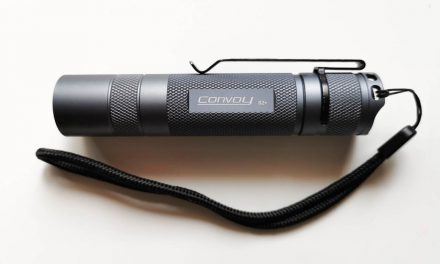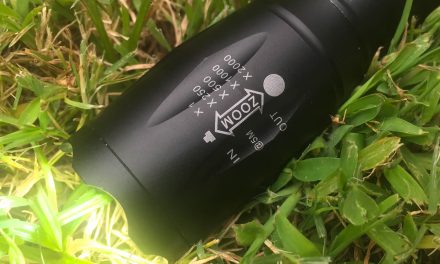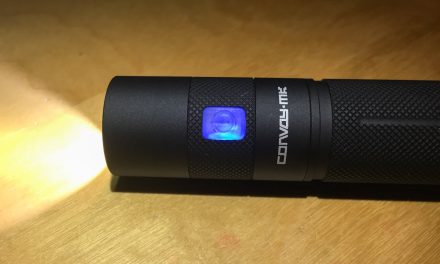
2019 Flashlight Buying Guide

There have been many changes in the flashlight (torch) market in the last year, including a shift away from Cree emitters, the lumens wars getting even more ridiculous, and an increase in 20700/21700 based lights instead of 18650. This has resulted in only a few new flashlights suitable for light painting. Thankfully there have been a few RGB colour mixing lights, and a strobe monster added to the market! Most of this article is written for flashlights that are suitable for the Light Painting Brushes (LPB) Universal Connector (25-38mm head diameter), and Light Painting Paradise (LPP) Adapters (20-38.5mm head diameter). Sections later in this article cover other connectors and use cases. An addition to this years review is an asterix (*) denoting that the light has internal recharging options (i.e. you dont need to use a seperate charger).
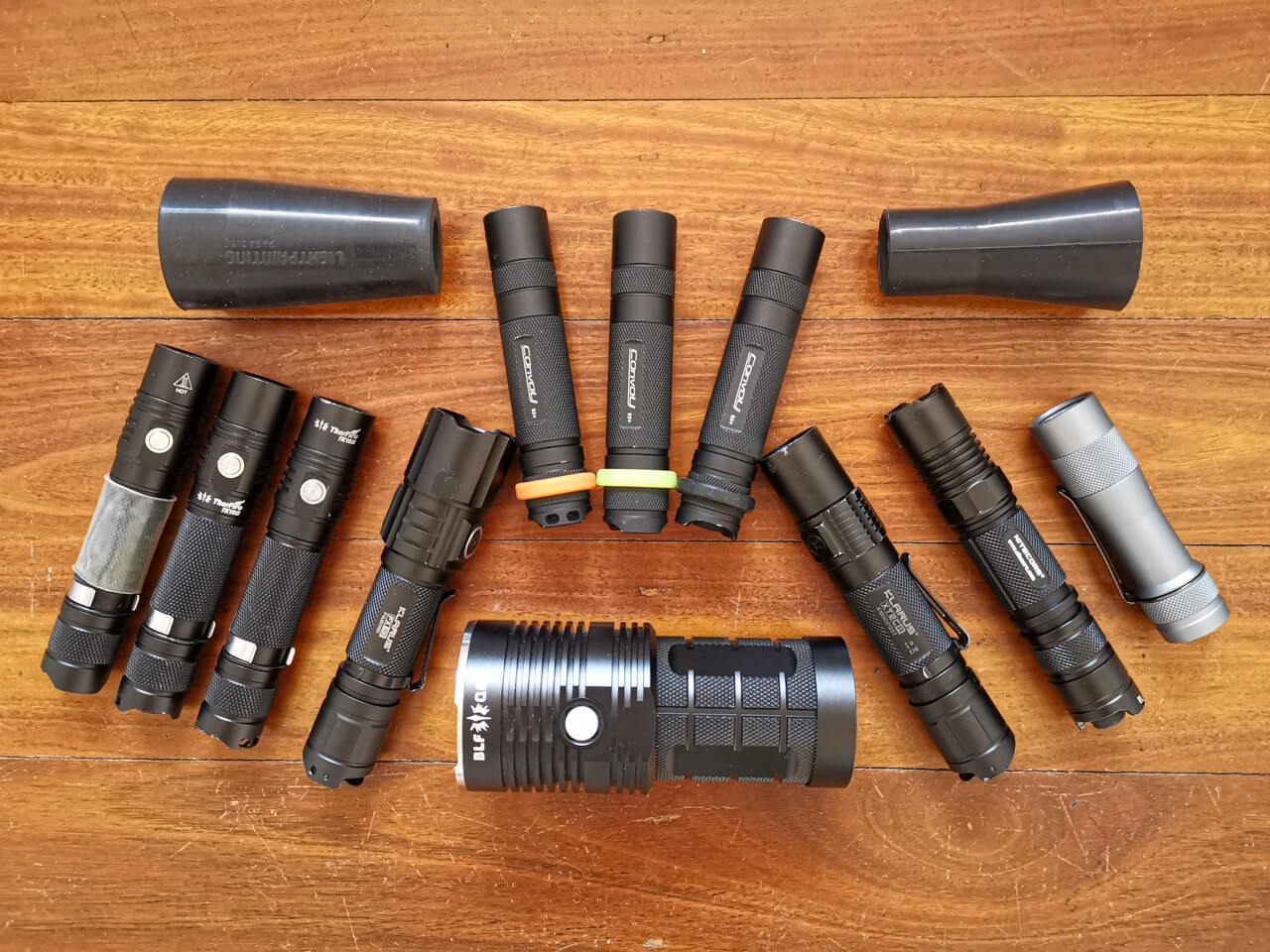
Some flashlights I use for Light Painting – Convoy S2+ (warm, neutral, and cool white), Ryuslightworks V2, Thorfire TK15S, Klarus FX10 and XT2CR, Nitecore P10GT, TLF/BLF FW3A, BLF Q8.
Foreword
It should be noted that the maximum output in lumens stated by manufacturers and in this article are rarely sustained, and most flashlights reduce in brightness at anything between 30 seconds and a few minutes. Be aware that some cheap flashlights (particularly on eBay, Amazon, various Chinese electronics companies), and many RGB colour mixing lights have highly exaggerated lumen ratings.
Whilst lumens (lm) are generally used to describe output, the peak beam intensity in candela (cd) or throw (m) also needs to be considered. The higher the peak beam intensity per lumen (“throwy” light), then generally the better the flashlight is for illuminating longer tools such as rods, swords, and tubes. A lower peak beam intensity per lumen (“floody” light), then generally the better the flashlight is for more even illumination of tools such as Fiber Optic Brushes and Plexiglass blades. Zoom lights allow for more flexibility, especially for controlled illumination purposes, but are far from essential. Experimentation is the key to see what works the best.
Switch location is also something that needs to be considered so that you can turn a flashlight on or off, or change modes during a light painting scene. Most (but not all) flashlights in this article either have tail switches or accessible side switches.
AA/AAA Battery Flashlights
Lights that use commonly found AA and AAA (alkaline or rechargeable NiMH) batteries are popular with many light painters, and those new to flashlights. However maximum output is less than most li-ion battery based lights. Thus these lights are better in darker ambient light conditions. Recommended zoom lights include the Ledlenser P7-2017 (450 lm) and MT6 (600lm), Coast G32 (355lm), G50 (355lm), HP5R (185lm), Polysteel 200 (320lm), Polysteel 400 (375lm), and TX9R (300lm). Recommended non-zoom lights include the Coast G26 (120lm), Energizer Vision HD 2AA (400lm) and 3AAA (250lm), Zanflare F2 (200lm), and Convoy T2 (250lm, may need padding in LPB connector). The Nitecore SRT3 (180lm) is discontinued but still available in a few places.
Li-ion Battery Flashlights – approx. 1000 lumens
Lithium ion based flashlights (usually using rechargeable 18650 batteries, but increasingly 20700/21700/26500) allow for much higher brightness, but also result in more heat. They all have lower output modes for situations when less output is more desirable, such as moonlit nights. Li-ion battery flashlights are usually much better value for money than AA or AAA based lights, but usage requires knowledge of the risks of li-ion batteries. Bright non-zoom li-ion lights that are in the 1000 lumens range (+/-250lm) include the Convoy S2+, S3, M1, and M2, Thorfire TK15S, VG10S, and VG15S, Sofirn SP31 and SF36, Atactical/Wowtac A1S*, Thrunite TC12v2*, Eagtac P25LC2, Soonfire DS31*, Klarus XT11S*, Nitecore P10GT, P12GT, MT22C, SRT5, Nextorch TA30, Folomov 18650S*, Zanflare F1*, Olight M1X and M2T, and TLF/BLF FW1A. These will usually run close to maximum brightness for at least a couple of minutes before automatic or manual brightness step-down, allowing for use in longer light painting scenes. Zoom lights that can reach 1000 lumens include the Ledlenser P7R* and MT10*, Walther Pro SL66r*, Wowtac A3S*, and Klarus FX10*.
Li-ion Battery Flashlights – 1500 to 2000 lumens
These are great in high ambient brightness situations, but can step-down in brightness after around 30 seconds due to the large amount of heat produced. These lights may provide up to a 1 stop photographic exposure advantage compared to previously mentioned 18650 flashlights. Recommended flashlights in the 1500-2000 lumens range include the Klarus XT2CR*, XT11GT*, 360X1*, Olight M2R*, Convoy S11, and S21A.
Flashlights with mode memory
Mode memory allows a flashlight to be turned on in the previously used mode. This avoids having to fumble through modes during a light painting scene. Flashlights with reliable mode memory include the Thorfire TK15S, VG10S, and VG15S, Sofirn SP31 and SF36, Soonfire DS31*, Fenix PD35TAC, Atactical A1S*, Thrunite TC12v2*, Nitecore P10GT, P12GT, MT22C, SRT5, and Folomov 18650S*.
Flashlights with momentary switches
Momentary switches (also known as “forward clicky”, “tactical”, or “temporary” switches) allow for more control over on and off, with a half press of the switch. These are very useful for light drawing or light writing. Lights with momentary on high mode only include the Ledlenser P7.2 and P7-2017, Olight M2R* and M2T, Klarus XT2CR*, XT11GT*, 360X1*, and FX10*.
Lights with momentary on all memorised (non-flashing) modes, allows for momentary functionality to be used in a range of different ambient lighting conditions, making the lights much more useful. Flashlights with this functionality include the Thorfire TK15S and TK18, Sofirn SP31, Atactical/Wowtac A1S*, Soonfire DS31*, Thrunite TC12v2*, Fenix PD35TAC, plus the Nitecore P10GT, P12GT, MT22C and SRT5. The Nitecore P10GT and MT22C can also be controlled by remote pressure switches for more creative freedom.
For lights that additionally have momentary for single frequency strobe, keep reading…
Flashlights with Strobes
Flashing modes can add to the creativity in light painting scenes. Lights with single frequency strobes are generally preferred by light painters. Options include the Convoy S2+ (10Hz with older 3/5 mode user interface), Convoy T2 (7.5Hz), Thrunite TC12v2* (12.5Hz), Atactical/Wowtac A1S* (12.5Hz), Zanflare F1* (10Hz), Ledlenser M7RX* (20Hz), plus Walther Pro PL50, PL55r*, PL60, and SL66r* (20Hz).
A few flashlights have a bike flash mode that can create interesting pulse effects. Examples are the Convoy S2+ Desert Tan (with newer Biscotti user interface), Thorfire TK15S and TK18, and TLF/BLF FW1A.
The combination of single frequency strobes and momentary functionality allows for fantastic creative control. Flashlights with both include the Olight M1X, M2R* (9Hz), Nitecore P10GT (10Hz with 33% on time), Nitecore MT22C (19.5Hz with 33% on time), Nitecore SRT5 (22Hz with 25% on time), Nextorch TA15 and TA30 (10Hz).
The TLF/BLF FW1A is a strobe monster (derived from the triple emitter FW3A) with variable strobe frequency, choice of two different strobe modes, plus new models include momentary functionality. However, it is only suitable for advanced/knowledgable li-ion flashlight users. The Light Excursion Deluxe RGB and Ignis Shop Color LED Torch* have variable strobe and pulse frequencies (strobe is up to 6Hz with 20% on time) which can be used with different colours. The Light Excursion Sport RGB light has multiple variable frequency strobe and pulse modes, and can be used with different colours. The Concentrate C5 also has programmable strobe patterns.

Created using Concentrate C5 (Pink strobe) and Ledlenser P7QC (Blue PWM).
Flashlights with Rotary or Ramping Controls and Momentary
Rotary or ramping controls allow for fine adjustment of brightness. These flashlights also have momentary functionality too! Options include the Thorfire TK18 (ramping), Nitecore P26, MT22C (rotary dial), SRT3, and SRT5 (rotary head). However you need to be careful with the P26 and MT22C that the dial does not turn when pushing the light into the connector.
RGB / Colour Changing Flashlights
Many light painting tools are available with, or can be used with high quality colour gels or filters, reducing the need for flashlights with coloured LEDs. However, colour changing flashlights can add to creativity. Lights with colour changing (but not colour mixing) options include the popular Ledlenser P7QC (RGBW), Ledlenser T2QC (RGBW), and Coast TX100 (RW-Cyan). The Light Excursion Sport RGB(W) has momentary controls for individual RGB(W) channels, which can be combined for some colour mixing, and also features variable strobe frequencies. Lights with single colour LEDs include Jaxman E2L Color (R,G,B,Y) and Maglite XL50 Spectrum Series (R,G,B). Light Painting Paradise sell a pack of 7 different flashlights in colours Yellow, Orange, Red, Purple, Light Blue, Blue, and Green.

Selection of RGB Lights – Ledlenser P7QC, Color Shine Flashlight, Light Excursion RGB Sport and RGB Deluxe, Threeworlds Concentrate C5, Ignis Shop Color LED Torch.
Colour mixing flashlights allow for a range of colours and various colour effect modes, but colour LEDs are less efficient, they are not as bright as white light sources. Most manufactures either exaggerate or don’t quote the lumen ratings – only tested lumen ratings are mentioned in this section.
The Light Excursion Deluxe RGB light (100lm) and Ignis Shop Color LED Torch* (150lm) are the equal brightest RGB colour mixing torches that I’ve tested when connected to light painting tools. The Light Excursion Deluxe RGB is proving very popular with light painters, has lots of effects modes, plus rotary dimmer and momentary switch. It is possible to change effects modes and colours on the fly. There are even double emitter options to attach 2 tools. The Ignis Shop Color LED Torch has the same effects modes, is rechargeable, but has a more simplistic user interface. The Concentrate by Threeworlds C5 (30lm, requires padding to fit in connectors) allows for excellent and easily programmable effect modes, but is not very bright, and has a tricky user interface. The Color Shine Flashlight (30lm) is cheap, dim, and unreliable, but has a good colour fade mode when it works. It is also rebadged by quite a few different companies. Other options that I haven’t tested, but worth considering are the Neon Saber T100*, or the flashlight component from the Fiberflies Pixelwhip and GloFX Space Whip Remix. Antsonamelon have launched their very promising RGB Critter* flashlight on Kickstarter, which will be delivered in mid-2020.
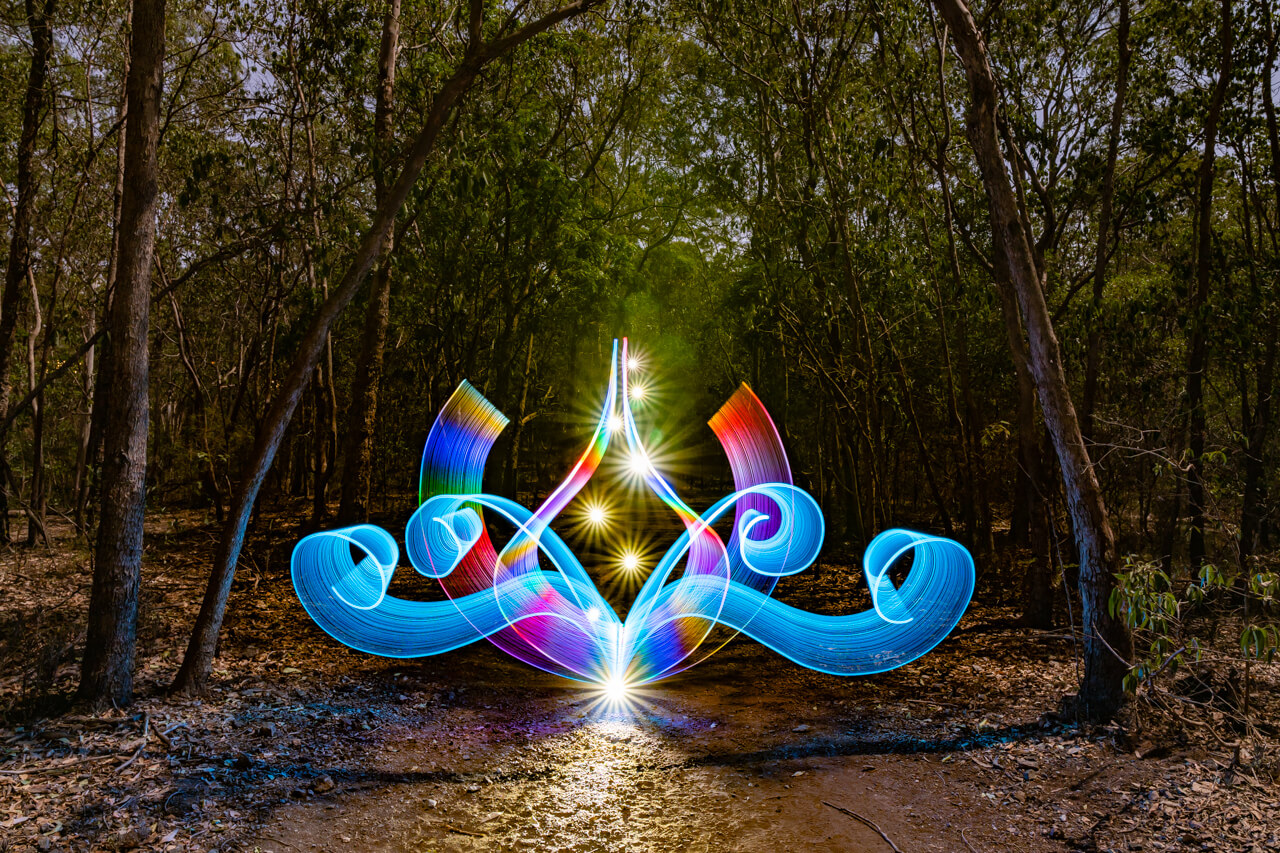
Created using the Light Excursion Deluxe RGB.
Neutral and Warm White Flashlights
Most flashlights are available in cool white tint (approx. 6500k CCT), which can be quite harsh. If you want a more “daylight like” beam, which is much better for illumination purposes, or warmer light trails, then look for flashlights with neutral white tint options (4000-5500k CCT). Examples are the Thorfire VG10S and TK15S, Sofirn SP31 (V1), Olight M2R*, Thrunite TC12v2*, Energizer Vision HD lights, Zanflare F1* and F2, Jaxman E2, E2L and M2 (which include high CRI options), plus the Convoy S2+, M1, M2, T2, and zoomable BD4* (choose xx-3x or xx-4x / 4000-5000k options).
Flashlights with warm white (3000k CCT) LEDs are much more rare, but are available in most lights made by Convoy (choose xx-7A / 3000k option), Sofirn SF36W, and the zoomable Maglite XL50 Spectrum Series warm white model.

Cool and Warm White Light.
Flashlights for Other Light Painting Connectors
So far this article has discussed flashlights that fit in the LPB and LPP connectors. I’ll also discuss a few other light painting systems. Firstly, the Liteblades KYO connector. This connector screws into the head of some Klarus lights, which allows for a solid connection for impressive fast snappy movements. This however means that it is only “officially” compatible with the Klarus XT11S, XT11GT, and XT12S (plus some older legacy Klarus models such as the XT11, XT12, and RS11). All are great lights, but fiddly if you only want to use single frequency strobe. All are compatible with remote pressure switches for improved control in some situations. I have also seen a KYO successfully attached to a Light Excursion lights with LE (grooved) connector, and it also possible to connect the KYO to the LPB Universal Connector.
Eric Paré’s Light Painting Tubes system is suited for 18650 tube lights with heads at approximately 25mm diameter and with side clips. There are many suitable lights, with the Olight M1X, Klarus XT2CR, and Nitecore MT22C being the most recommended. Other options includes the Thrunite TC12v2*, Eagletac D25LC2 Tactical and Clicky, Nitecore SRT5, P10GT, P12GT, and Folomov 18650S*.
Apologies if I’ve missed out any other commercial light painting connectors. Please let me know so that they can include them in future articles.
Very High Output Flashlights
There are of course many use cases where a connector is not required, and the flashlight is just required for illumination or backlighting purposes. If you need a light that can sustain more than 1000 lumens for a long period of time, then these are good options. Budget options are the BLF/Thorfire/Sofirn Q8 (5500lm, and includes a useful tripod thread), Sofirn SP36 (6000lm), Sofirn SP70 (5500k), Convoy L6 (4300lm), and Emisar D18 (14,000lm). Mid-price options include the Acebeam X80-CR95 (4500lm high-CRI), X80 (25,000lm with RGB-UV options at lower output), and X80-GT (32,000lm). Olight’s X7R* (12,000lm) and X9R* (25,000lm) are popular in the consumer market, and being rechargeable, don’t require li-ion battery expertise. If you need zoom, the Ledlenser MT18* (3,000 lumens), new X21R* (5,000 lumens), or the Jaxman Z1 XHP50 (2,200lm) are recommended options.
Other Notable Lights
The Protomachines LED8 colour mixing flashlight appears to currently be in limited supply, however the less expensive Protomachines Radium also has similar professional features including exposure timers. The Yongnuo YN360 is an excellent budget video light wand that has RGB colour mixing options, and powerful (2500lm) white output with variable colour temperature. It can illuminate, or be used to create light trails. The Mk1 version requires a Sony NP-F compatible battery and charger to be purchased separately. The Mk2 version has integrated charging. The LumeCube 2.0* (1,500) is a new improved (higher-CRI and slightly less cool white) version of the popular LumeCube* (1,500lm) and has flexible attachment options, bluetooth remote control from smart phones, and USB recharging. The Litra Torch 2.0 (800lm) is an alternative high-CRI option, but with no remote control. There are of course also lots of flash units, video lights, string lights, novelty lights, and illuminating light painting tools that are outside the scope of this article.
Conclusion
There is a wide range of lights suitable for light painting, at all price points. There is no single “do everything” light, and thus I would recommend building up a collection of lights to meet as many of your light painting requirements as possible.
I usually state which flashlights are used for Light Painting photos on my Instagram account, so check that out if you are interested to know which light was used to create a specific effect.










